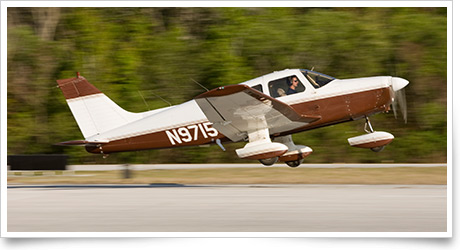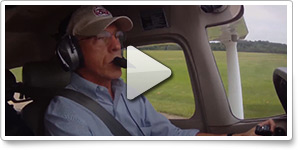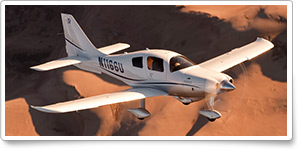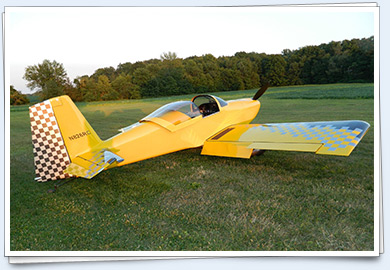Aug. 24, 2012, issue of 'AOPA ePilot: Flight Training Edition' weekly newsletter
| ||||||
| Ready to roll? |
| |||||
Training TipsReady to roll?
Before any takeoff, you are required to comply with a regulation on preflight action that calls for you to familiarize yourself with runway lengths, and takeoff and landing distances provided in your aircraft’s approved flight manual. Consider the Air Safety Institute’s 50/50 rule of thumb. The institute recommends adding 50 percent to the pilot’s operating handbook takeoff or landing distance over a 50-foot obstacle. For example, if the distance over the obstacle requires 1,600 feet, add 800 feet for a safety distance of 2,400 feet.
Your preflight inspection and your pre-takeoff checklist, which includes checking magneto function, setting the fuel-air mixture, and verifying that the fuel selector is properly positioned, provide assurance that the aircraft is ready to fly.
What takeoff technique will you use? If departing via the short-field method, be sure to use all available runway. If there is an obstacle to clear, review the recommended climb speed to maintain until well clear. For a soft-field takeoff, the key to proper execution is to break ground promptly, and then accelerate in ground effect until reaching an airspeed that allows you an efficient climb with full control authority.
Whether departing via the short- or soft-field method, be sure to apply control deflection for any crosswind during the takeoff run. Then correct for drift in the climb.
Suppose the runway has a displaced threshold. Can you use the entire runway for your takeoff? (See the Oct. 1, 2004, “Training Tip: Displaced thresholds.”)
Where is your abort point? Select a visible point before you roll. Obviously a rough-running engine is a reason to abort, but other concerns—sluggish acceleration, losing directional control in gusty winds, or an anomalous instrument indication—could prompt the decision. Your aircraft should produce a stated rpm when takeoff power is applied. Check early in the run for that performance. One rule of thumb is to discontinue takeoff if you have not achieved 70 percent of liftoff speed halfway down the runway.
Speaking of technique, firm, not abrupt throttle application will provide a smooth, straight takeoff roll. Similar smoothness at rotation will deliver a liftoff free of wallowing. This is something to practice on all training flights.
Remember to calculate takeoff and climb performance based on actual conditions. High elevation, temperature, and the aircraft’s loading can erode or even retard your aircraft’s ability to become airborne and climb. Estimating performance may not provide an accurate result as a recent, well-publicized takeoff accident illustrated.
A safe takeoff is a careful blend of aircraft performance, pilot decision making, and technique. Flight Training NewsWomen’s flight academy to take off in TexasFor the second year in a row, a Texas designated pilot examiner and her band of volunteers will host a weeklong academy aimed at helping women to advance in their flight training. Girls in Flight Training (GIFT) will take place Nov. 3 through 9 at Wilbarger County Airport in Vernon, Texas. Read more >> Washington state teen solos four taildraggersMany student pilots have been known to solo more than one airplane on their big day. Ben Littlefield of Kent, Wash., may get extra points because he soloed four tailwheel aircraft. Littlefield turned 16 on July 22, and to celebrate, he soloed his mother’s Stearman biplane. He then flew the family’s Cessna 185 and 140. He finished it up by soloing his father's Piper PA-18—the same airplane in which he’d first flown at the age of just 3 weeks. Ben is the son of Keith and Molly Flanagan Littlefield, who are both professional pilots and describe themselves as very active in general aviation. NBAA offers academic scholarshipsThe National Business Aviation Association (NBAA) is offering academic and career training scholarship opportunities to qualified applicants. The Janice K. Barden Aviation Scholarship annually awards $1,000 to each of five undergraduate students studying aviation-related curricula at NBAA and University Aviation Association member institutions. The deadline to apply is Nov. 1. NBAA also sponsors schedulers and dispatchers monetary and training scholarships; the deadline to apply is Sept. 28. See the website for complete information and application. What you can’t see can hurt youYou’ve seen the crash footage and read the comments, but do you really know what it is? You can’t see it, feel it, hear it, or smell it, but your airplane’s engine will certainly know it’s there. Every year, pilots challenge the insidious effects of density altitude … and many of them lose. So what should you expect to encounter when flying in a high-density-altitude environment, and how can you avoid those pilots’ mistakes? Find out with the Density Altitude online quiz from the Air Safety Institute, underwritten by AOPA Insurance Services. Take the quiz >> Training ResourcesWeather theory is often the least understood subject in flight training. You may pick up the required knowledge to pass the checkride—but do you really understand it? Do you grasp the big picture? Unless you’re a professional meteorologist it’s sometimes tough to pinpoint the finer nuances of the weather forecast vis-à-vis your flight plan. Why not bolster your preflight repertoire with weather fundamentals found in the Air Safety Institute's WeatherWise: Air Masses and Fronts course? Terms like isobars, drylines, Coriolis force, and occlusions will have a crystal-clear new meaning after you take the course.
Did you know that student pilots who join AOPA are three times more likely to complete their flight training? Membership includes unlimited access to aviation information by phone (800/USA-AOPA, weekdays from 8:30 a.m. to 6 p.m. Eastern time) or from Flight Training Online or AOPA Online. If you’re not already a member, join today and get the pilot’s edge. Login information is available online. Idaho airplane crash Career PilotU.S. airlines' workforce up slightly over 2011The Department of Transportation reported that U.S. airlines’ employment rose 1.7 percent from June 2011. Total full-time and part-time employment for all passenger, charter, and cargo carriers for June was 585,807, up from 576,208 in June 2011. A report in the Hudson Valley, N.Y., Times Herald-Record noted that while overall employment numbers had increased, the numbers were down from May 2012, when 586,781 were employed. American Airlines flight attendants approve new contractThe Association of Professional Flight Attendants said its members at American Airlines voted to approve a new contract offer 59.5 percent to 40.5 percent, according to The Associated Press. The contract includes numerous concessions as the airline seeks to cut costs in bankruptcy protection. The flight attendants join the airline’s mechanics and other union workers who have accepted new contracts; pilots rejected the company’s last offer. AOPA Aviation SummitExhibit hall hub of activity at SummitNot only can you peruse hundreds of aviation exhibits, test pilot products and gear, and watch new product announcements in the Palms Springs Convention Center exhibit hall during AOPA Aviation Summit, but you can mingle with fellow pilots and learn new techniques and tips to improve your flying at the Learning Pavilion and Interactive Lounge in the show hall. Read more >> Discounts for Summit hotel reservations expire Sept. 7Lock in low prices at luxury hotels and resorts in Palm Springs, Calif., which has invested $200 million in new properties and renovations since AOPA’s last convention there in 2006. During AOPA Aviation Summit, Oct. 11 through 13, enjoy mountain and poolside views; indulge in bright desert colors and relaxed, muted tones; and rest in plush accommodations at any of the 11 AOPA hotels. Prices fit every budget and style, from spa, casino, golf, and trendy spots, to smaller boutique inns and suites. Check out the hotels and their amenities; book by Sept. 7 for advance discount rates. Plane SpotterCessna Corvalis: Sizzling speed Training ProductsFree learn to fly e-bookPrivate pilot Ted Seastrom says he wished he’d known about some of the pitfalls that can occur with flight training. That’s why he wrote a book about it and is now offering it as a free download. Learning to Fly an Airplane is not a how-to book, says Seastrom, but rather a look at each stage of the training process and a discussion of unexpected challenges that can occur. “As a recent student, I believe you will improve your chances for success if you know more about flight training going in. You’ll definitely have more fun and less frustration,” he says. The book is available at his website.
Note: Products listed have not been evaluated by ePilot editors unless otherwise noted. AOPA assumes no responsibility for products or services listed or for claims or actions by manufacturers or vendors. Member BenefitsThe FAA wants to talk to me … now what?What should a pilot do when the FAA “wants to talk”? The request for dialogue might come in a letter or a telephone call from an FAA inspector. It could be a controller’s question to you over the radio or a request that you telephone the tower after landing. Whenever the FAA wants to initiate a conversation to explain some incident involving your flying activities, you need to be careful as there can be a lot at risk. Attorney Kathy Yodice gives advice as part of AOPA’s Pilot Protection Services. Read more >> BlogsThe short listProfessional pilot Chip Wright says every airline crew has one: a short list of captains you’d rather not fly with. Also in this week’s Flight Training blog, learn who made the cut in Technical Editor Jill W. Tallman’s list of readers’ aviation heroes. Genevieve: Taking to the skiesLet’s Go Flying’s newest blogger is Genevieve Beaulieu, a student pilot and aviation management major at the Florida Institute of Technology. Genevieve wasn’t an airport kid—she only recently got bitten by the aviation bug. Read more in the Let’s Go Flying blog. AOPA Career OpportunitiesEver dream of turning your passion for aviation into a career? We’re looking for a director of media relations, director of legislative affairs, major gifts officer, accounts payable technician, administrative coordinator, director of new market development, aviation technical generalist, and Web graphic designer. To learn more about other AOPA career opportunities, visit AOPA Online. Community
AVIATION EVENTS & WEATHER
| ||||||||||||||||||||||||||||||||||||




 Takeoff is a brief phase of flight, a product of
Takeoff is a brief phase of flight, a product of 




